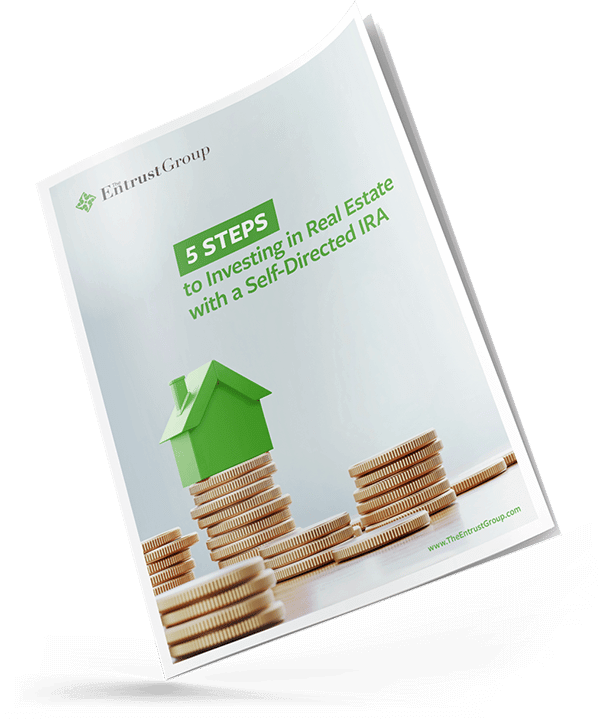How to Invest During Inflation: Consider Alternative Assets

Estimated reading time: 7 minutes
In April 2023, inflation fell below 5% for the first time in two years. While many investors are hoping the decline signals a soft landing, this monthly figure is still the highest since the financial crisis of 2008.
Inflation can erode the value of your portfolio over time, leaving you with less purchasing power and potentially lower returns.
Fortunately, there is one tried-and-tested strategy to help protect against inflation: diversification. Spreading risk over several different asset classes like real estate, private equity, and precious metals can offer a bigger cushion for an economic downturn.
There are certain asset classes that have demonstrated historical resilience against inflationary pressures. In this article, we'll explore some alternative investments that may help protect your portfolio during times of high inflation.
Note: Entrust does not endorse, recommend or advise on any investment product or service. Rather, Entrust provides the administration, information, and tools to make self-direction straightforward and compliant.
What About Stocks and Bonds?
The vast majority of wealth held in retirement savings is in the form of stocks, bonds, and mutual funds. These assets generally lose value during times of high inflation.
When inflation rises, companies may have to spend more on raw materials, wages, and other costs, which can cut into their profits. This can cause investors to become concerned about the future earning potential of the company, leading to a drop in stock prices.
Additionally, inflation can lead to higher interest rates, which can increase borrowing costs. This reduces consumers’ disposable income and the demand for goods and services, hurting company earnings.
Bondholders don’t escape unscathed, either. As rates rise, the demand for existing bonds with lower yields decreases, causing their price to fall. This is because the fixed interest payments become less appealing compared to the higher yields offered by new bonds. As a result, bondholders who want to sell their bonds before maturity will receive less than face value.
In contrast, many alternative assets can fare quite well during times of high inflation. However, many IRA providers don’t have the ability to let their clients invest in alternative assets. That’s where a self-directed IRA (SDIRA) comes in.
What Investments Can Protect Against Inflation?
An SDIRA enables investors to diversify their portfolios with alternative assets.
Alternative assets often possess intrinsic value not directly tied to the value of traditional currencies. For instance, a house still has value even if the currency is in freefall. The worth is derived from inherent characteristics and demand, which can provide a level of protection against eroding purchasing power during inflationary periods.
Further, some alternative assets can experience increased demand as investors seek tangible assets to hedge against rising prices. Limited supply and increased demand may lead to price appreciation.
Of course, it's important to carefully consider the risks and rewards of any investment. It’s wise to consult with a financial advisor before making any decisions. Investors should have a long-term strategy and be prepared to hold onto their investments for an extended period of time.
Due to the illiquid nature of many alternative assets, SDIRAs are well-suited for long-term planning. An impulse distribution often isn’t practical. For instance, private equity investments often contractually bind the investor to a set duration of ownership. This safeguards the tax-advantaged status of your funds and protects your nest egg from early withdrawal penalties.
Now, here are five alternative assets that have historically performed better during times of high inflation.
Alternative Assets That May Protect Against Inflation

1. Precious Metals
The US Treasury abandoned the gold standard first in 1933, and then entirely in 1971. In the decades since, many investors have continued to devote a slice of their portfolios to gold and other precious metals.
Precious metals, such as gold, silver, and platinum, are often considered valuable investments during high inflationary periods. They tend to hold or even increase in value as the currency loses its power.
Generally speaking, these tangible assets are not easily affected by changes in inflationary pressures. Additionally, precious metals are often seen as a safe haven asset. Investors tend to flock to them during times of economic uncertainty or instability, which can also drive up their value.
For instance, during the inflationary period of the 1970s, the price of gold rose from $36 per ounce to over $614 an ounce. This equates to a ten-year gain of 1,606%. During the same time frame, the S&P 500 stock market index rose from $83 a share to $118 a share, a ten-year gain of 42%.
Granted, that same market swing is unlikely to repeat itself. However, the fact remains that precious metals have historically been one of the better-performing assets during an era of a declining dollar.
2. Private Equity
As many venture capital firms are reining in spending, a vacuum may open for adventurous SDIRA holders to fill.
Private equity (PE) investments can provide a hedge against inflation through their potential for higher returns. While PE investments can bring higher amounts of risk and uncertainty, they also can offer incredible growth potential.
These investments often involve longer holding periods and may be less sensitive to short-term market fluctuations. This makes them a potentially attractive option during periods of inflationary pressure.
Historically, times of financial uncertainty have formed many of the most coveted blue-chip stocks.
Two of the most valuable companies today, Apple and Microsoft, scrambled for private equity investors in the inflationary time of the late 1970s.
The Dot-com bubble of the late 1990s swallowed many budding businesses, but it also created some of the most profitable firms today, including Google.
The financial crisis of 2008 led to the founding of Airbnb, Uber, and Instagram.
The greatest opportunities for private equity growth often lie in times of financial uncertainty and technological disruption. Since OpenAI released ChatGPT in late 2022, the tech industry has been in a tailspin, with each company releasing its own version of artificial intelligence in an attempt to keep up.
At this very moment, the next disruptor could be seeking private equity investments from a Visionary Investor to revolutionize their industry. Not sure where to find your next investment opportunity? Our clients have access to Entrust Connect, our online investment marketplace.
This community grants access to a vast spectrum of investment opportunities, from budding technology companies to established property development firms. Offerings are updated frequently, and each option on the platform has been invested in by one of your fellow Entrust clients.
While technology startups are valued for their sky-high growth potential, they can also bring a great deal of financial risk. It is crucial to conduct your own comprehensive research before making any firm decisions. If you’re unsure about a particular asset, consult with a trusted professional or investment advisor.
3. Infrastructure
Transportation, energy, communication, and utilities.
These investment sectors might not be as naturally exciting as others, though they provide many of the essential services that we use every day. Many consider infrastructure to be the backbone through which all other industries can thrive. For that reason, it may be one of the most inflation-resistant asset classes.

Infrastructure assets, such as toll roads, bridges, airports, and power plants, tend to have long-term contracts and stable cash flows. This revenue can increase with inflation, making your portfolio more durable in times of a declining currency.
These investments often have long useful lives and are not easily replicated. This makes them less vulnerable to the impact of inflation on replacement costs.
4. Real Estate
As many renters can tell you, inflation often coincides with rent increases. This effect amplifies in times of widespread housing shortages, as many markets in the US are experiencing right now.
In fact, the fair market rate for a 2-bedroom apartment increased more than 35% from 2020 to 2021 in high-rent states like New York and Massachusetts. This effect can put extra pressure on renters, though it can be a boon for property owners.
Investing in a thriving real estate market may prove difficult if you have limited personal savings. With an SDIRA, investors can tap into a substantial pool of retirement funds that may be otherwise inaccessible. This allows them to make a direct purchase of a real estate investment without depleting their personal accounts or taking on a risky mortgage based on their personal credit.
Additionally, SDIRAs allow you to partner your funds on the initial purchase of a real estate asset. In this strategy, investors may combine their retirement funds with the funds of other individuals, IRAs, or even their own personal funds.
By pooling resources, investors can access a larger capital base. This opens up opportunities for more substantial real estate investments that may have been beyond their SDIRA’s financial capacity.
However, partnering is only allowed on the initial purchase of assets. Any commingling of funds with disqualified persons after the fact could disqualify your IRA’s tax-advantaged status. And remember, you may not stay or live in your IRA-owned home, nor may any other disqualified persons.
As long as your IRA owns the property, you can rent it out for a fair market rate. This will not only help you recoup costs, but it will also allow you to build equity in an asset that has historically appreciated over time.
Be aware, if your SDIRA takes on debt to finance a real estate purchase, you may have to pay Unrelated Debt-Financed Income (UDFI) tax. This tax ensures that property owners who use tax-advantaged funds don’t have an unfair advantage in pricing against other property owners.
5. Private Lending
As the economy continues to burn hot, the Federal Reserve has hiked interest rates from a near-zero in early 2022 to over 4.8% in April 2023. Their hope is to slow spending and bring down inflation to more manageable levels.
However, rising interest rates may provide an opportunity for investors. SDIRA holders are now able to charge borrowers higher rates, which translates to higher returns.
Private lending typically involves shorter-term loans. This allows investors more flexibility to adjust their investment strategy in response to changing market conditions.
Plus, private lending investments are often secured by collateral, which can provide additional protection for investors in the event of default by the borrower.
Diversify Your Portfolio With Alternative Assets
Inflation is one of the top concerns for many investors, especially those saving for retirement.
By diversifying your portfolio with alternative investments such as private lending, private equity, and infrastructure, you may be able to mitigate the negative effects of inflation. In fact, you could even profit from it.
As always, it's important to consult with a financial advisor and thoroughly research any investment opportunity before making a decision.
If you don’t yet have a self-directed account, explore your options at Entrust. With over 40 years of experience empowering investors, we can provide access to alternative assets to help you build an inflation-resistant investment strategy.





























0 Comment